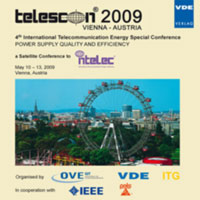Overview to ETSI Standards and Guides for Efficient Powering of Telecommunication and Datacom Equipm ent and Building
Conference: telescon(R) 2009 - Power Supply Quality and Efficiency - 4th International Telecommunication - Energy special conference
05/10/2009 - 05/13/2009 at Vienna, Austria
Proceedings: telescon(R) 2009 - Power Supply Quality and Efficiency
Pages: 6Language: englishTyp: PDF
Personal VDE Members are entitled to a 10% discount on this title
Authors:
Schulz, Wilfried (ETSI, 650 route des Lucioles, 06921 Sophia Antipolis, Valbonnes, France)
Abstract:
Telecommunications networks worldwide are evolving rapidly into systems carrying over the broadband services with Internet, cable TV and other data traffic in addition to traditional voice telephony, and operators are seeing a large increase in Internet equipment installed in their networks. This development has influence to the actual existing standards for the power supply interfaces. European Telecommunication Standardization Institute (ETSI) is the regional organization that is recognized by the EC and EFTA as one of the three official standards-making bodies in Europe, and is responsible for standardization in the whole field of telecommunications, including radio, broadcasting and private telecommunications. The requirements for the power distribution to the interface „A" for -48V/-60V are standardized in the ETSI EN 300 132-2. The mixing of the traditional telecommunication equipment with new broadband and IT equipment in the Central Office (CO) and access network need a solution for the powering and safe installation (earthing, grounding, batteries) with higher efficiency and reliability. In the year 2003 was published the ETSI EN 300 132-3 for direct powering the transmission equipment with 400 V. In several workshops on the INTELEC 2003, 2004, 2005, 2006, 2007 and 2008 and worldwide initiatives were discussed the different experiences and solutions in connection to several pilot projects. A wide use of DC in electrical installations offers high energy efficiency, and improves power quality in the AC distribution network. The presentation will give a small overview to the standardization in the last 6 years with the actual results, problems and trends in the worldwide realization of higher efficient powering of the new internet equipment.


